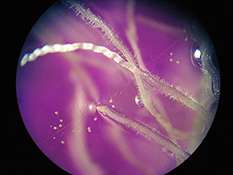Infrared sheds light on beneficial microbes

Infrared spectroscopy can quickly spot beneficial fungi on roots in soil, according to U.S. Department of Agriculture (USDA) soil scientist Francisco Calderon.
This type of spectroscopy has become established practice for quick and reliable analysis of grain and forage quality, as well as for other agricultural uses, thanks in part to work by scientists with the Agricultural Research Service (ARS), USDA's chief intramural scientific research agency.
But Calderon, who works at the ARS Central Great Plains Resources Management Research Unit in Akron, Colo., is the first to explore using the technology to detect fungal-root associations in soils.
The ability to quickly analyze field soils for these beneficial fungi, called mycorrhizae, would allow scientists to judge which crop rotations or other farming practices increase mycorrhizal fungi. This is important nationwide to improve crop yields, and especially critical in semi-arid areas like the Central Great Plains.
Mycorrhizal fungi live in a symbiotic relationship with plants. The fungi extend the reach of plants by taking up nutrients and water that would otherwise would be difficult for plant roots to reach. In exchange, the fungi feed on the carbon sources that plants provide.
Calderon says the test could simplify, speed, and make more objective measurements of mycorrhizae in root samples compared to the standard method of visual scoring through a microscope. Calderon developed the technique with ARS soil scientists Veronica Acosta-Martinez and Merle Vigil, at Lubbock, Texas, and Akron, respectively. Colleagues in this study also include David Douds, an ARS microbiologist in Wyndmoor, Pa., and James Reeves, an ARS chemist in Beltsville, Md.
The scientists measured the reflectance of infrared light from dried, powdered carrot root samples. They found that the cell wall chitin and fatty acids in mychorrhizal fungi have distinct spectral signatures, absorbing infrared at wavelengths different than standard chitin and fatty acid samples and different than non-mychorrhizal root samples.
They plan to study the spectral properties of other crop-fungal species to see whether there are universal spectral signatures for this important group of organisms.
More information: This research was published in the Journal of Applied Spectroscopy. www.springer.com/physics/atomi … hysics/journal/10812
Provided by USDA Agricultural Research Service

















